Reader's Choice
Popular articles
Increased body temperature is possible with various diseases in childhood. At the same time, the question of whether to shoot her down causes a lot of controversial opinions.
Someone from the parents heard that during fever the body is more actively fighting the disease, and if the temperature is brought down, the duration of the disease will increase. Others have heard that both its elevated values and the drugs against it are very dangerous and threaten serious health problems.
Important to check elevated temperature at least twice a day, because most of the daytime temperature changes and can vary from elevated temperature to temperatures above 38 degrees Celsius and against which drugs should be taken against temperature or any other physical measures.
So, how to measure the temperature? In young children, preferably in the rectum. Beware of interpretation, as the temperature in the body cavities is half a step higher than on the surface of the skin, that is, compared to the armpit. If the child does this, we measure the temperature in the armpits. It is also possible to measure the temperature of the head or special thermometers in the ear canal, but the measurement is not so accurate.
As a result, some parents are afraid to bring down the temperature, even in cases where it is required, others give crumbs with a slight increase. Let's see what really needs to be done in these cases, and whether this symptom is a symptom of the disease.
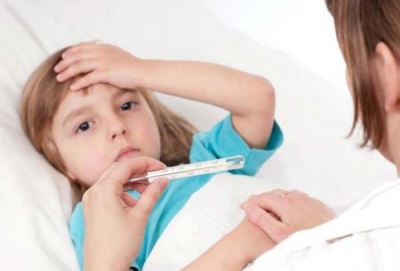
At a temperature of up to 38 degrees Celsius on the surface of the body, we provide the child with peace of mind, comfort, lighter clothes, plenty of warm fluid and repeatedly checking the state. At higher temperatures, up to 39 degrees, we cure temperature and try to reduce the temperature with the help of physical measures.
If the temperature rises to 40 degrees and lasts a whole day, we try to reduce it with medication and look for a doctor that day. At temperatures above 40, 5 degrees Celsius, we take drugs against the temperature, and we immediately look for a doctor. It often happens that parents measure a fever - even high ones take a child and immediately go to the emergency room without taking medication against fever. This is a risky situation, especially for children aged six months to six years, who may have febrile seizures at high temperatures, during which the child may suffocate when the tongue enters the throat.
The measurement in the armpits is the most accessible and simple, so it is most common.
However, there are other ways to measure:
It is important that the child has a separate thermometer, and before use it should be treated with alcohol or washed with soapy water.
When such a situation arises, it is necessary to release the child in the respiratory tract unconscious and immediately seek medical attention. Another complication of fever is the lack of fertilization of the child’s body, which can be further aggravated by vomiting or diarrhea. We always make sure that the child drinks at least as much liquid as in a normal state; the liquid must be rather warm or cold and can be referred.
Medication and physical measures for fever. Medications to reduce the temperature also act against pain and are controlled according to the rules of the leaflet and the weight of the child. They are available without a prescription and are presented in the form of tablets, syrups or suppositories. At introduction it is necessary to be careful not to exceed the maximum daily dose and to maintain the set distance between doses. If you take medicine on the third day without significant effect, you should visit or consult a doctor.
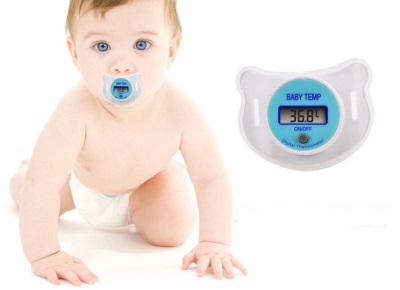 Measure in infants now just with the help of a thermometer dummy
Measure in infants now just with the help of a thermometer dummy
Also, when measuring you need to follow the following rules:
The features of temperature in infants are inconsistency and rapid increase in any disease. In addition, in infants up to a year, it is normally slightly higher than in older children.
Beware of acetylsalicylic acid, which is contained in many drugs to reduce the temperature, which can not be given to children under the age of fifteen years. Medicines can also be combined with physical methods against temperature, which are mostly sponges or tears. In a bath with some warm water, the baby will wash the sponge for about ten to thirty minutes. The surface of the baby's skin is cooled by evaporation of water.
We do wraps with a towel or a towel dipped in warm water to wrap the baby’s fruit for about ten to fifteen minutes. The wrapper can be repeated twice within two hours. However, if these methods appear as mutations or chills, you must stop them immediately.
The normal temperature for a child under 12 months is less than + 37.4 ° C, and for a child over 12 months - less than + 37 ° C. These are measurements of temperature in the axillary region, as well as in the inguinal fold. For rectal measurements, the norm is considered to be less than + 38 ° C, and for oral, less than + 37.6 ° C.
The use of a mercury thermometer gives the most reliable indicators, while electronic thermometers have a significant error. To find out how different the electronic and mercury thermometer indicator is, measure the temperature at once by two thermometers from any healthy family member.
Finally, it should be emphasized that a child with a fever should not be left without attention, and his condition and temperature should be constantly monitored. The child should be calm and comfortable, drink a lot of drinks, and if parents are worried about their condition, they should consult with their child’s doctor or emergency services at least by telephone or directly.
When to immediately see a doctor with a fever? Whenever the fever does not fall during the third day, or the temperature above 39, 5 degrees cannot take twenty-four hours. Also, when a child drinks little or is dehydrated by diarrhea and vomiting. In addition, when the child is sluggish, he does not respond to speech, has movement disorders, has severe headaches and a so-called stiff neck, so he cannot bow his head.
Depending on the indicators, the temperature is called:
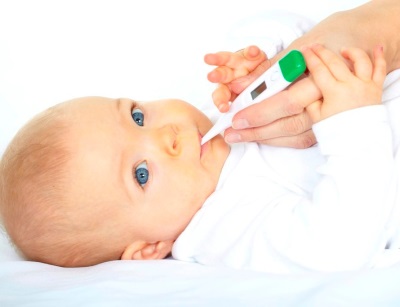
In addition, if he has very cold hands and feet, or so-called marble skin or has bloody spots on the skin. For a child up to three months each time we measure more than 38, 5 degrees Celsius in the rectum. Frequent causes of fever in a child are all types of infections - bacterial and viral. They are usually accompanied by other, very characteristic symptoms - rhinitis, dry or wet cough, sputum secretion and several others. Most of the onerous symptoms are accompanied by bacterial infections.
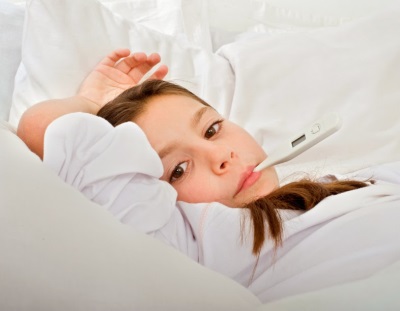
Viral infections are usually milder. Their only symptom may be fever without any other symptoms. Children may indicate, for example, the flu. High temperatures, accompanied by a sense of discomfort and musculoskeletal pain, and sometimes high fever, can be a symptom of such diseases of influenza or influenza.
It is important that the cause of the infection are bacteria or viruses. Bacterial infection is usually associated with high temperatures. Acute inflammation of the throat and tonsils, regardless of etiology, can manifest itself only by fever. Older children usually report sore throat and sore throat during illness, but in children younger fever may be the only symptom.
To start the mechanism of raising the temperature of the body usually need foreign substances entering the body of the child - pyrogens. They can be various infectious agents represented by unicellular, viruses, protozoa, fungi, bacteria. When ingested, pathogens are absorbed by white blood cells (leukocytes). At the same time, these cells begin to produce interleukins that enter the brain with blood.
In young children, teething may be the cause of the fever. The temperature of the child is usually low, sometimes it can be just a fever. Parents most often indicate that fever fluctuates within 38 degrees Celsius. The kid is annoyed, does not want to eat and sleep. Characteristically, the child inserts various objects in the mouth to alleviate the discomfort associated with teething.
Not every temperature in a baby without any other symptoms should be interpreted as a sign of teething. Parents should be especially vigilant when childhood fever lasts 3 days or longer. Then you should consult a doctor who will examine your child and rule out other causes.
Reaching the center of regulation of body temperature, located in the hypothalamus, these compounds change the perception of normal temperature. The brain of the baby begins to determine the temperature of 36.6-37 degrees as too low. He gives the command to the body to produce more heat and simultaneously spasm blood vessels to reduce heat transfer.
In this process, the following stages stand out:
Homemade teas are all specially designed to facilitate teething. Some cool in the refrigerator because low temperatures reduce discomfort. A high fever in a summer child that is not accompanied by other symptoms may be associated with an infectious viral disease, a sudden erythema, commonly referred to as “three days”. The general name of the disease is due to its typical course - the child feverishly for 3 days, often high, after which the fever disappears, and a rash-papular rash appears on the skin.
It should be noted that the temperature can decrease lytically (gradually) or critically (sharply). The second option is very dangerous expansion of blood vessels and lower blood pressure.
Despite the high temperature, the baby usually stays in good general condition. Sudden swelling is a disease in which fairly frequent febrile seizures occur, especially on the first day, with a rapid rise in temperature. Therefore, it is important to control the temperature of the child’s body and to use antipyretic drugs and physical therapy in a timely manner.
A very common disease in which fever is the only symptom of a urinary tract infection. Typical infections of the urinary tract - burning, tingling, pain and discomfort during urination - are not communicated by the child, often children, despite the disease, absorb the diaper well.

Numerous studies have confirmed that in some infections, fever contributes more quick recovery. It was also found that the use of antipyretic for some time prolongs both the time of the disease itself and the period of infectiousness. But, since these effects do not apply to all infections with high fever, it is impossible to speak about the unequivocal benefit of fever.
This makes every case when a child has a fever, especially a small one, it is worth doing a general urine test. Urinary tract infections are especially sensitive to children with an anatomical or functional defect in the urinary tract. The best example is ureteral reflux. These children often have recurrent urinary tract infections.
Chronic disease as a cause of fever in children
Over time, other symptoms are added to the fever. This is a syndrome of generalized inflammatory response, which is a fever syndrome of more than 38 degrees Celsius or hypothermia, tachycardia, tachypia, an increased or decreased blood leukocyte. There is also a significant increase in other inflammatory markers. In addition to an elevated temperature, the child may not exhibit other symptoms of the disease.
Scientific studies have shown that active compounds produced at high temperatures (interferon among them) in some cases help to recover faster, and in some diseases affect their course negatively. In addition, for many children, this is a very dangerous condition.
For a long time, high fever was considered a factor capable of disrupting blood clotting and causing overheating of the brain. Therefore, it was feared and tried to reduce in all sorts of ways. However, modern scientific research has shown that it is not heat itself that leads to health problems, but a disease that is manifested by such a symptom.
As noted, fever in children without any symptoms can have various causes, starting with teething, generalized inflammatory reactions and serious chronic diseases. Fever should be examined by a doctor, in young children and in children with an increased risk of urinary tract infection.
Always take home remedies to reduce your child’s fever. They depend on the age of the patient. Not all medicines can be used before the end of the year. Watch for a cool cotton diaper stick. This can help cool the neckline. Body cooling is indicated especially in children of 6 months - 5 years who are prone to febrile convulsions.
In this case, doctors note that fever is a danger to children with chronic pathologies of internal organs, symptoms of dehydration, impaired physical development or diseases of the nervous system.
The danger of hyperthermia lies in the large expenditure of energy and nutrients to maintain a high temperature. Because of this, the internal organs overheat and their function is impaired.
Over-the-counter medicines are available in older children - in the form of drops, syrups and fever pills. Contraindications to acetylsalicylic acid are contraindicated. If the cause of a baby’s fever is a viral illness, it can be dangerous for his or her life. The main drugs are paracetamol and ibuprofen. Lemon extract is a good and safe cure for a child's fever.
Firstly, the correct way of intervention depends on the child’s age and body temperature. Thus, for a child less than 3 months, any value greater than 38 degrees Celsius requires medical examination. For children aged 3 to 6 months, medical consultation is required if the body temperature exceeds 38, 5 degrees Celsius, and persons older than six months require medical advice when the temperature is above 39, 5 degrees Celsius. But it requires emergency medical care if the fever is accompanied by symptoms such as sore throat, earache, headache, painful urination, muscle pain, fatigue, dehydration, shortness of breath, weeping, inconsolable, chills, difficulty walking, skin irritation, stiff neck, severe abdominal pain.

It is determined primarily by the age of the baby:
If you see on the thermometer the numbers indicated above in the table, this indicates a high probability of a serious disease, therefore it is extremely important to immediately call a doctor for such temperature measurements.
It is usually recommended to churn the febrile temperature if the child does not tolerate this condition very well, however there are situations when it is worthwhile to give a febrifuge also for subfebrile indicators:
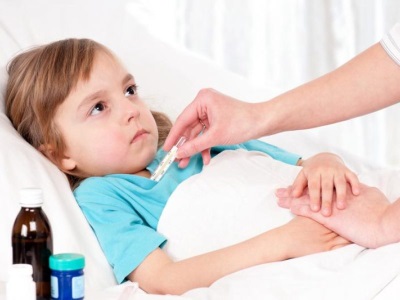
Heat rarely the only manifestation of a child’s health problems. Other signs of disease join it.
Redness of the throat against fever is characteristic of viral and bacterial infections affecting the nasopharynx. Such symptoms often occur with angina, scarlet fever and other childhood infections. The child complains of pain when swallowing, begins to cough, refuses to eat.
The combination of high fever and runny nose is most common with viral infectionswhen viruses infect the nasal mucosa. A child may also have symptoms such as weakness, refusal of food, difficulty breathing through the nose, lethargy, sore throat, cough.
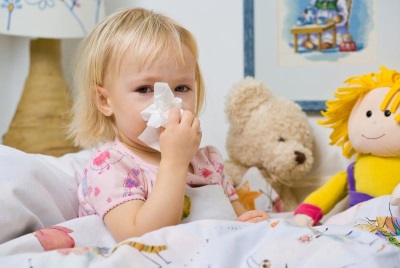
A condition when the child has pale skin at elevated temperature and her blood vessels are cramped is called white fever. To the touch the limbs of a baby with such a fever will be cold. The child usually has chills. This condition requires immediate medical attention. The body of the child should be rubbed with his hands, but the use of wiping with water and other methods of physical cooling is prohibited. To relieve a spasm of skin vessels, the doctor will recommend to take a spasmolytic, for example, No-silo.
Increased body temperature can cause seizures. Because of their association with fever, such convulsions are called febrile. They are diagnosed in children under 6 years of age with rates above + 38 ° C, as well as in babies with pathologies of the nervous system in any figures.
When febrile convulsions in the child begin to twitch the muscles, legs can be straightened and arms bend, the baby turns pale, does not respond to the environment, it is possible to hold your breath and blue skin. It is important to immediately lay the baby on a flat surface with his head turned on his side, call an ambulance and not leave the baby for a minute.
 Febrile seizures are very dangerous. You must immediately call a doctor!
Febrile seizures are very dangerous. You must immediately call a doctor!
Such symptoms with fever usually indicate an intestinal infection, but they can also be caused by the use of certain foods by a young child. In babies younger than 3 years old, the intestines are not yet fully matured, so those foods that are normally tolerated by older children can cause dyspepsia and fever.
In addition, the combination of fever with vomiting can signal not only the defeat of the gastrointestinal tract. Such symptoms are characteristic of meningitis and acetonemic syndrome. In children younger than 7 years old, vomiting can occur at elevated body temperatures and without damage to the brain or the digestive system. It happens at the peak of an increase in temperature, usually once.
The appearance of complaints of pain in the abdomen in the background of fever should alert the parents and cause an ambulance call. This can lead to serious illnesses requiring surgery (for example, appendicitis), kidney diseases, and diseases of the digestive tract. To clarify the reasons, the child will be assigned tests and additional examinations.
The absence of other signs of disease often occurs during dentition, as well as in situations where the disease is just beginning (other symptoms appear later). High fever, as the only symptom, is often noted in kidney infections. To confirm the disease can be urine tests and ultrasound study.

The increased temperature is a protective reaction of the child’s body to the entry of pathogens into it, but it can also be due to non-infectious causes.
A very common cause of fever are infectious diseases:
|
Disease |
How does it appear besides high temperature? |
What to do? |
|
The appearance of a runny nose, dry cough, complaints of sore throat, body aches, muscle pain, nasal congestion, sneezing. |
Call a pediatrician, give a lot of drink, if necessary, give a febrifuge. |
|
|
Chickenpox or other childhood infection |
Rash, sore throat, swollen lymph nodes in the neck. |
It is imperative that you call a doctor so that he accurately diagnoses and recommends the correct treatment. |
|
The appearance of pain in the ear, as well as discharge from the ear, cough, runny nose. |
Contact a pediatrician for an examination of the child and the appointment of an appropriate treatment situation. |
|
|
Infectious mononucleosis or tonsillitis |
Severe sore throat, the appearance of plaque on the tonsils, an increase in lymph nodes in the neck. |
Urgently call a doctor to clarify the diagnosis and start treatment immediately. |
|
Urinary tract infections |
Pain in the lower back or abdomen, painful and frequent urination, changes in the smell and appearance of urine. |
Contact a pediatrician to get tested, identify the disease and start treatment. |
|
Intestinal infections |
Attacks of vomiting and nausea, spasmodic pain in the abdomen, disorder of the stool. |
Give the child more drink, stop feeding, call the pediatrician. |
An increase in body temperature is also possible in case of diseases of non-infectious genesis, for example, problems with hormones, pathologies of the nervous system and other health problems. It may also indicate acute surgical diseases that require immediate medical attention.
This reason is very common in younger children, but the indicators are usually up to + 38.5 ° C. In rare cases, the fever can be very strong, and the child refuses to eat and is sluggish.
Additional signs that indicate precisely the connection of teething and high temperature will be enhanced salivation, redness of the gums, restless naughty behavior of the baby. The child will chew on different objects and hands.
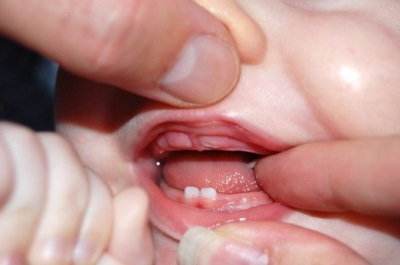
In case of overheating, parents notice a connection between the increase in temperature and the effects of heat on the child, for example, a fever appeared after a long stay in the sun. In infants to overheat may cause the use of excessively warm clothing. Also, parents can themselves provoke overheating when a baby is wrapped up with a small increase.
The danger of overheating is associated with the risk of thermal shock. It is manifested not only by high fever, but also by impaired consciousness, convulsions, impaired heart and breathing. Heat stroke is a reason to immediately call an ambulance.
Preventive vaccination can cause a rise in temperature within a few days after the procedure. In this case, the child may experience swelling and pain at the site of the vaccine. These symptoms indicate immunity and are considered acceptable. side effects vaccinations. At the same time, antipyretic drugs can be given even with a slight increase in performance.
The doctor should be called in each case of fever, as only a specialist will be able to determine what caused and how to treat the baby.
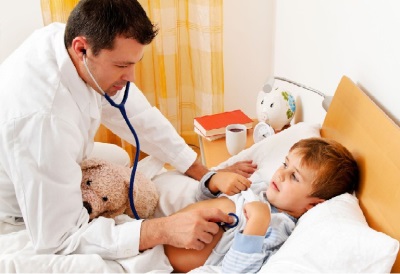 The doctor will prescribe effective methods treatment and will control the course of the disease
The doctor will prescribe effective methods treatment and will control the course of the disease
Indications for an immediate doctor’s call are such situations:
Once the cause has been identified, it is necessary to determine how to deal with such a symptom. Taking into account the state of the baby, his age, temperature figures and related facts, the parents and the doctor decide whether they need antipyretic drugs.
In most cases, such drugs allow, albeit briefly, to improve the condition of the child, to allow him to sleep and eat. With angina, otitis, teething, stomatitis, these drugs reduce pain.
Used in the past, rubbing with vinegar, alcohol or vodka today are considered pediatricians harmful procedures. Doctors do not advise wiping the child even with a cool towel, because such actions provoke a spasm of blood vessels in the child’s skin, and this in turn will reduce the heat transfer. In addition, alcohol-containing liquids when rubbed will actively get into the body of the child, which is fraught with poisoning of the baby.
Rubdowns are permissible only after the use of drugs prescribed by a doctor, relieving spasm of peripheral vessels. For the procedure using only water at room temperature. In addition, wiping the child can be provided that the baby does not mind, as with resistance and shouts, the temperature will increase even more. After wiping the child should not wrap, otherwise his condition will worsen.
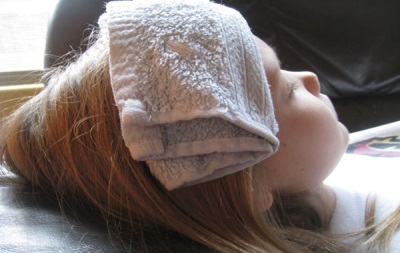 You can do wiping with cool water only after taking drugs that relieve spasms of peripheral vessels
You can do wiping with cool water only after taking drugs that relieve spasms of peripheral vessels
Drinking a child with fever should often and a lot. Give your child tea, compote, water, juice or any other liquid that he agrees to drink. This is extremely important for heat transfer through greater evaporation of sweat from the skin, as well as for more rapid elimination of toxins in the urine.
Food should be given to the baby in small quantities. Let the child eat by appetite, but a little, because when digesting food, the body temperature will increase. And the dishes and drinks offered to the child, the temperature should be about 37-38 degrees.
They recommend drinking tea with the addition of cranberries: it stimulates active sweating. At the same time, such a drink should be given carefully - in infants up to one year old, it can cause allergies, and older children should not use cranberries for any stomach ailments.
Another great folk remedy with antiseptic and antipyretic effect is raspberry, which can be given to a child in the form of jam, juice or tea. But in cases where there is a risk of allergies, the use of raspberries is best avoided.
 Cranberry juice is an excellent remedy for acute respiratory viral infections for both adults and children.
Cranberry juice is an excellent remedy for acute respiratory viral infections for both adults and children.
For a baby, not the fever itself is dangerous, but the cause of the appearance of this symptom. If the parents are not aware of the fact that the temperature of the baby was raised and the state did not improve the next day after the increase, as well as additional warning symptoms appeared, you should immediately seek medical help. So you determine the cause of the child’s illness and can influence it, and not just the symptom.
If the cause of hyperthermia is known to the parents, and it does not constitute a danger, the doctor examined the child and prescribed therapy, the temperature can be reduced for a few (3-5) days while observing the child. If there are no positive changes in the course of the disease over the past three days, despite the treatment, you should call the doctor again and undergo an additional examination.

Drugs that are recommended in children at high temperatures are paracetamol and ibuprofen. Both remedies reduce pain equally, but ibuprofen has a more pronounced and prolonged antipyretic effect. In this case, paracetamol is called safer and is recommended as a drug of choice for babies in the first months of their lives.
Breast babies are often given such preparations in the form of rectal suppositories or syrups. This is due to the ease of use of these forms - they are easy to dose and give the child. In older children, preference should be given to tablets, syrups and soluble powders.
The action taken through the mouth of drugs begins within 20-30 minutes after their use, and rectal suppositories - 30-40 minutes after administration. Candles will also be the most preferred option in the presence of bouts of vomiting in a child. In addition, syrups, powders and tablets often include additives for taste and smell, which can cause allergies.
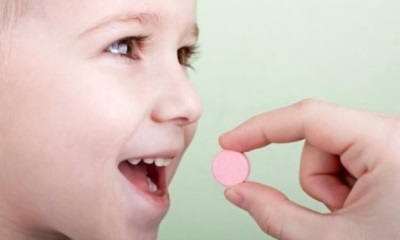
You may hear recommendations to take paracetamol and ibuprofen together or with alternating these drugs. Doctors believe that it is safe, but not a necessity. The combination of these drugs acts with the same efficiency as taking ibuprofen alone. And if you have given this medicine, and the temperature does not decrease, do not give paracetamol in addition, it is better to call an ambulance right away.
Even as an adult, it is advised to avoid using aspirin at a temperature where possible, and it is completely contraindicated in children under 18 years of age.
In childhood, aspirin has a pronounced toxic effect on the liver and is the cause of the development of serious complications, which doctors call “Ray's syndrome”. This syndrome affects the internal organs, in particular the liver and brain. Also, taking aspirin can affect platelets, cause bleeding and allergies.
 Aspirin has many side effects and its use for children is not acceptable.
Aspirin has many side effects and its use for children is not acceptable.
Toggle navigation
During the second pregnancy, I often heard the “soothing” phrases of adults aunts: “The first child grows in her arms, the second on the floor, the third on the street.” And she believed that the second is easier. There is an "experience - the son of difficult mistakes!" Like, any runny nose and the temperature of the child is not so much forced to worry mom. Do not believe, I tell you, aunts.
Our first temperature occurred on the 14th day of the birth of the crumbs. In unconsciousness, with shaking hands, covered with red spots from nerves and trembling in my voice, I called an ambulance. I remember, having examined the baby, the doctors became more interested in me. Instructions followed to give me a drink of motherwort, valerian and warm water. Then the wise doctor looked into my eyes and slowly explained the situation with the temperature of the child. If we shorten his speech, then our business is not so bad. Belly, long cry because of colic and hot room - this is his verdict. Help was provided, the child's temperature dropped, and mother fell into sleep.
After you read the text about my struggle with the temperature of the child and the victory won, you will not have the fear that covered me in the minutes when the thermometer 37 and 1. You will find out what our grandmothers actually did to knock down temperature, tell you a secret "conspiracy" of the sores and share information about what color bedding can not be laid in the heat of a child. I want to describe all the actions that really helped me to cure children, but it will be a question of common colds, and otherwise I recommend going to doctors.
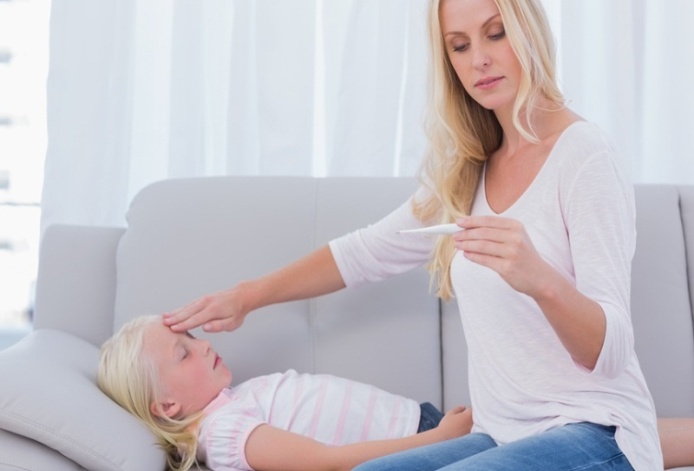
It usually starts all prosaic. A baby full of activity suddenly becomes capricious and lethargic. More and more he is not satisfied with the furnishings, toys, the cartoon is not happy, the proposal to play is rejected. One word - the world is hostile. I could notice a chill, an unhealthy blush on my face or pallor, an extinct gaze, a desire to lie down, embrace, requests for pens, drowsiness. All this taught me to determine the heat without a thermometer. Naturally, after detecting the symptoms, we took a thermometer, only a mercury (!), It is more accurate, and determined the temperature.
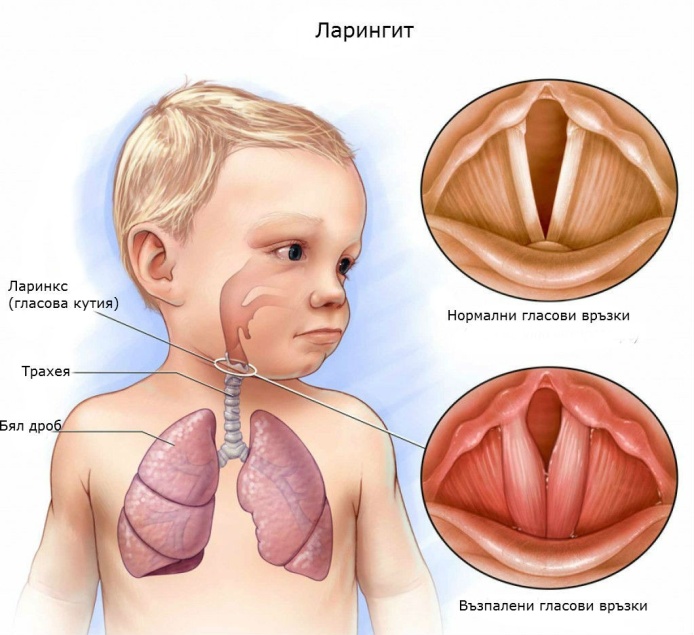
Symptoms of the throat are usually accompanied by the phrase: "Mom, it is not convenient for me to swallow." To me it sounded like: “You are surrounded. Resistance is futile". What to do and where to start? Who is to blame and how will he answer for it? After a stormy: “After the bath, I told you to put on socks, close windows, doors, shutters, wrap around like a mummy in a scarf and not breathe on the child for everyone,” common sense began to prevail and I began to act. Grandfather method always works. Menovazin! It is an odorous liquid that contains menthol, anestezin, novocaine and alcohol, helps to quickly relieve inflammation, pain, and warm. If there is no high temperature, we smear the neck from ear to ear behind (it is very important to do this) and in front, and then rub the feet of the child. Take the spray Meramestin (it has no taste, like children) and attack the infection an hour after irrigation of the throat with warm tea (chamomile can) with lemon. I am not a fan of pharmaceutical herbal sprays and mixtures because of the possible manifestation of a child allergic reactions. In addition, pediatricians in one voice confirm my fears. A sore throat is a signal that goes inflammatory processimmune response. Common causes - sore throat, pharyngitis. Pharyngitis can occur on the background of influenza or acute respiratory infections. In this case, purulent deposits do not appear in the throat and it will be enough just to use antiviral treatment. Usually, in five days, the symptoms stop bothering and the throat comes back to normal. I connect the active warm drink, cranberries, a lot of vitamin C and foot baths. Be sure to well ventilate the room several times a day. And in order to envelop my throat and reduce pain, I give bananas! Frequent rinse "rotokanom" (our doctor recommends it as the best and inexpensive means) will help children of older age to remove the inflammatory process in the throat.

It also happened that the disease began with complaints of the tummy. The fact is that the virus attacks everyone in different ways. Some cause problems with the digestive tract, others suffer more throat. The stomach may be sick due to a bacterial or viral type of infection, constipation, nutritional problems, intestinal obstruction, drug reactions.
Vomiting, discomfort in the stomach and stomach, refusal of food and even drinking, high temperature in a child are frequent satellites and the usual ARD. At this time, it is recommended to drink a lot, but gradually. Start with a teaspoon of regidron rastov or plain water. Diet - crackers (white) home made and rice in water 1 tablespoon at a time.
If nausea and stomach are disturbed from birth, I use the indispensable Phosphalugel. It perfectly wraps and adsorbs, is used from infancy, pleasant and sweet to the taste.
Sometimes, fever manifests itself in the form of aches throughout the body. It seems that all the skin is a solid bruise and any touch gives not very pleasant sensations. Joints, knees, legs, arms can hurt. Typically, this state passes when it is possible to reduce the temperature and provide the child with bed rest.
Yes, pain in the head, knock on the temples, pressure on the back of the head - all this is a manifestation of high temperature and pressure changes. Doctors recommended that we give Ibuprofen and Nurofen syrups for headache and toothache. Grandfather smeared his temples or cheeks, as well as the neck from ear to ear with Menovazin. I usually used both means at once.

Happened and such. The main thing is to determine the frequency. Mild upset and stool 2-3 times, or is it impossible to get up from the pot? The first thing you should pay attention to is color, smell, quantity and quality. Prevent dehydration by taking Regidron according to the instructions. Include a diet (white rice for water cereals) and try to get the child to drink rice water (even a teaspoon). Often, diarrhea and fever are rotavirus infections or intestinal flu.
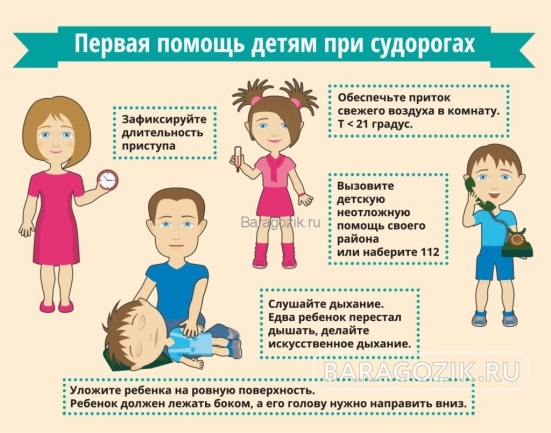
It happened to me to watch and this sight. The high temperature of the child, more than 39 degrees, led to convulsions. At the time of convulsions, it is important to lay the child on its side and try to hold the tongue in order to exclude its ingestion. This can be done with a small roller of bandage and other available tools. And holding the child and the roller wait a few seconds. After the child regains consciousness, give a febrifuge and call an ambulance.
What to do before the arrival of the doctor?
How to bring down the temperature at home?
Rubdown at high temperature?
Cool the room, ventilate. Monitor the active drinking regime (transparent drinks that contain glucose - decoctions of raisins or dried apricots, plain water, compotes). Put to bed in light clothing made from natural fabrics of light color. To warm the legs, if at high temperatures they are very cold.
Intuitively, I always thought that wiping with vinegar or vodka was nonsense. Inhalation of alcohol or vinegar vapors by a child plus absorption of these substances into the blood will not be of any benefit. It is necessary to wipe with water in 34 degrees not lower, otherwise there will be a spasm of blood vessels (pale and blue skin). Dr. Komarovsky always says that pale or blue skin is a reason to call doctors. Monitor the temperature until the arrival of the doctor. I rang literally every ten minutes to an ambulance and consulted how much I needed.
Candles and syrups by temperature
The better to bring down the temperature of the child?
Antipyretics?
Permissible high temperature in children?
I used what was more suitable for my children on the basis of practical application - “Ibuprofen” or “Paracetamol” in the form of syrup. It is better to keep both of these funds. Can one in syrup, and the other in candles.
With the permission of the pediatrician, I gave a syrup every 4 hours if our temperature was above 38. Considering the fact that one child had a history of convulsions, doctors recommend not waiting for the high temperature and reducing it from 37.5, this is an acceptable high temperature. After talking with many pediatricians and not only, I realized that the most ancient method of analgin + Dimedrol is not recommended very much. It is an effective remedy for reducing heat, but with so many undesirable side effects. Antipyretic drugs act within an hour, which means that the child will not immediately have a decrease in temperature, but in 30–60 minutes.
What temperature is considered normal in premature babies?
My son was born at 32 weeks (a normal gestation period is 38 - 40 weeks). After 1.5 months in the hospital, he became stronger and became incredibly plump - 2.5 kg! Compared to birth weight, this was exactly the case. One evening I noticed that the child, dressed adequately in the temperature of the room, was still cold. The thermometer did not deceive my suspicions and showed 35. Doctors warned that premature babies need some time to control heat transfer. I dressed the child warmer, turned on the heater and covered the baby with a blanket. Action was enough. After 10 minutes, the temperature was 36 and 4. All these tips were given to me by telephone by emergency doctors.
Premature babies can overheat just as easily and their body temperature will rise in normal conditions for us. Otherwise, such children behave in exactly the same way as full-term ones.
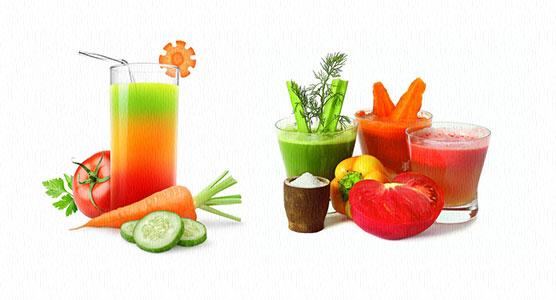
Folk remedies with fever or symptoms leading to it
From generation to generation, you can hear a lot of tips, called folk. Not everyone was ready to listen. To pour cold water on the child, to wipe with alcohol-containing substances, to give water to raspberries (it is not always beneficial), to give honey (allergy and warming effect) I was not ready. However, I have collected in my piggy bank many effective remedies for the treatment of symptoms that cause fever in a child. Among them are the most common:
The most effective secret is my means transferred from my grandmother, which can be given from birth and allergies (because it is not in the composition of honey) - beer syrup. It even treats bronchitis. The real find with this ailment at any age, believe me.
A bottle of light beer +2 lemons with skin, but without bones ground with a meat grinder + 1 cup of granulated sugar. All put it on water bath in order to evaporate the alcohol! It is impossible to boil this remedy, but it is necessary to give it to the water bath for 15 minutes later. Strain. Take 2 sips every 30 - 60 minutes throughout the day. With a slight cough about 3-5 days, with a strong 10 - 14 days. Until the symptoms disappear.
The second means more traditional - potato compress. Boil the potatoes and mash it with a fork. Fold in several layers of cheesecloth and put mashed potatoes in it. This compress is placed in the area chest and keep until the potatoes completely cool.
For older kids, I gave black radish with honey.
My fidget could not be persuaded to such methods as breathing over the steam covered with a blanket or smearing the glands with all sorts of solutions. We were looking for effective and humane recipes J
I used this recipe from the birth of my second child, the first time at her monthly age.
Wrap cabbage sheets around the throat so that the child can comfortably move and feel comfortable. Cabbage very well relieves inflammation, pulls pus, warms.
Drink warm decoction of raspberry branches. Give fresh (you can buy frozen and thawed) cranberries with sugar, it has a lot of vitamin C.
The important point is to start right away! It all starts with a diet that excludes dairy products, sweets and bakery products. All this contributes to the formation of mucus in the body.
It is possible to warm the nose (nose) with a boiled warm egg or salt heated in a dry frying pan, placing it in bags of natural fabric - cotton or gauze. Warming baths with dry mustard for feet and hands will also help with a cold.
Conspiracies, prayers, secrets or just tips on temperature
I believe that childhood diseases are often the result of the state of the nervous system of the baby, the situation at home, the result of the internal state of the mother. And there are various prayers, all kinds of rituals and rituals. But I am an analyst by nature. It is important for me to understand the logic of action and not to go to extremes. Break a lot of sources, I found for myself the most optimal way in matters of "conspiracy" at high temperatures in children or colds. All of them are quite simple and I would say logical. These words are recommended to say psychologists and healthy children. Therefore, I boldly reveal the secret of my whispers to you.
There is similar information on the Internet, but not everywhere you will find important “trifles” that you “forgot” to write when you printed these words.
And so, "little things":
Put the child in a clean light-colored bed, ideally - snow-white, but you can pastel blue. Let bed linen be made of natural fabric. Wear a child in white cotton clothes. Exclude dark colors and colors that are associated with fire and heat - red, burgundy, black, brown, blue, crimson, etc.
When the baby falls asleep, after about 15 minutes, the active phase of sleep begins. At this time, the mother must be calm. Sit next to the child and look at him.
Say out loud:
These words are spoken to the child during the awakening. Next, go to the child's health: (imagine your baby healthy, active, laughing, remember one of the most fun and good days)
It is very important to speak with a positive and positive attitude. Do not use a piece of "not"! Speak in the affirmative - healthy, breathing easily and freely (instead of you do not have a cold, does not have a sore throat).
Another secret. This treatment is positive emotions! Always, since childhood, my mother argued that positive emotions - joy, laughter, delight, heal much better drugs. It can be a story and a plan for a trip to an amusement park with a bunch of gifts, balloons and all that the child will be very happy about. Meeting with friends, surprises. Give the baby gifts not as a promotion of the disease, but “by chance”. Children especially need attention and love. Believe me, these words are not a standard sentence to complete the text. They are like magic able to lift from their knees and give strength. Ask the universe for health, give thanks and love!
| Related articles: | |
|
How to choose the color of varnish to clothes?
Selection of lacquer color is not a simple matter, because its shade is due not only ... Contract of sale of an apartment
The package of documents required for the conclusion of the contract of sale ... Annual tax on cars
That each owner of the vehicle, ... | |